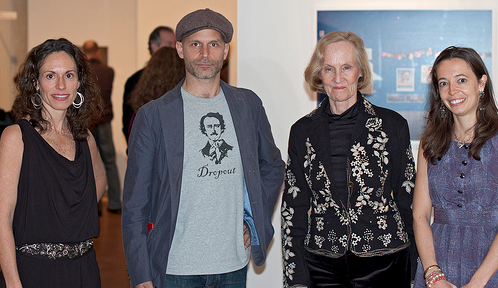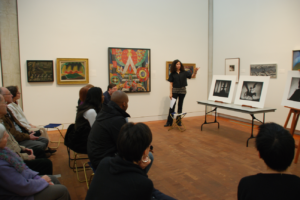For today’s post, student docent Anna Rogulina interviewed Mary-Kay Lombino, the Emily Hargroves Fisher ’57 and Richard B. Fisher Curator and Assistant Director for Strategic Planning. Lombino curated the Art Center’s current exhibition, 150 Years Later: New Photography by Tina Barney, Tim Davis, and Katherine Newbegin. Photographer Tina Barney will lecture about her work tonight at 5PM in Taylor Hall, Room 102.

Anna Rogulina: How and when did the idea for this exhibition come about?
Mary-Kay Lombino: In 2009 we decided we wanted to do something to celebrate the 150-year anniversary by commissioning new work and I proposed to invite photographers to campus to capture Vassar today.
AR: How did you go about assembling the “dream team” of artists to work on this exhibition?
MKL: I see a great deal of contemporary photography and there are so many talented artists working today. This made the selection process both difficult and easy. I had worked with each of these artists before and I knew their work. I knew that they would be inspired by campus as a subject in very different ways. They are also each in different stages of their careers which added to the variety.
AR: Can you talk a little bit about your involvement in the selection process of photographs? Were you usually in agreement with the artists about which works would be included in the show?
MKL: I helped guide the artists somewhat by making suggestions about what they might find interesting to shoot, but for the most part they chose their own subjects and worked independently. I saw some of the contact sheets with various shots of the same subject and gave my input on which works I thought were the most successful. Other than that, it was entirely up to each artist what works they wanted to include. Nothing was turned down.
AR: Do you remember the impression you had of the photographs after seeing them for the first time? How, if at all, has it changed now that you have spent more time with the photographs?
MKL: The biggest change for me was going from seeing small .jpegs or working prints of the images to seeing the photographs framed and hung on the walls in the galleries and relating to the other artists’ work. They went from individual shots to a collective project that projects a particular image of Vassar.
AR: Which photograph(s) were you most surprised by?
MKL: All of them. Often I would talk to the artists after a day of shooting and they would say something like “I took pictures of the squash coach” or “of an empty dorm room”, or “of the chapel basement” and I would conjure an image in my head. The resulting photographs were never anything like what I imagined. That is a testament to the talent these three artists have for taking something rather banal, and making it something much more interesting on film.
AR: In your opinion, is there a theme or story that strings together the diverse set of works found in this exhibition?
MKL: I don’t think a theme or story necessarily but a setting. These pictures could only be one place and that’s Vassar. They are not generic college campus shots by any stretch. But, then again, they are not the typical view of Vassar either. They speak to the individuals involved, on both sides of the lens. The individuals who took the pictures and those who make Vassar what it is today.




